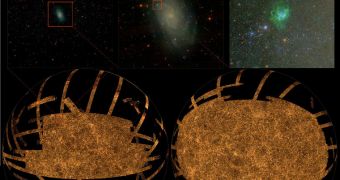The 2012 NASA budget bill proposed by the US House Appropriations commerce, justice, science subcommittee calls for the cancellation of the NASA James Webb Space Telescope (JWST), but the scientific community is highlighting just how devastating that would be.
Over the past decades, it's undeniable that remarkable progress in science and technology was the sole driver in our quest for knowledge. Many of the things we now take for granted about the Universe were discovered by using the tremendous power of computers and advanced telescopes.
Though they don't come cheap, space observatories are an essential component in this exquisite mechanism. They have a unique vantage point, peering back into the early Universe to a time when the first stars appeared on the firmament.
Galactic surveys are just one example of a field of research that is innovating our understanding of space. The Sloan Digital Sky Survey (SDSS), one of the largest ever, is analyzing millions of galaxies and other objects, revealing how they evolve over time.
“We're relying on a variety of different techniques to probe deeper into the past,” astronomer Timothy Heckman says of studies meant to reveal mysteries related to the earliest days of the Universe.
“A brute force approach is just using very large telescopes on Earth and observatories in space to detect extremely faint distant objects,” adds the expert, who is based at the Johns Hopkins University (JHU).
“Astronomers are also using fortuitous events such as explosions known as gamma ray bursts – gamma ray telescopes in space can detect these sudden flares from the distant Universe and learn more about the objects that caused them,” he adds.
The NASA James Webb Space Telescope – designed as a replacement for the Hubble – would augment these capabilities to a great extent. It is the most ambitious and complex space observatory ever planned, and there was a time when the United States was not afraid to dream this big.
However, things obviously change, and the US is now pouring money into war rather than science. While the Pentagon spends trillions of dollars on the war effort, science and technology costs are being reduced on a yearly basis.
Machines such as the JWST, which already took billions to build and feature the most advanced technologies in the world, are snubbed for attack helicopters and aircraft, regardless of the fact that they can actually shed some light on how life appeared, and why we are here.
If allowed to develop, the JWST could show how the first galaxies appeared, how black holes formed and why, how supernovae change the galaxies that house them, the nature of spacetime, and so on, Space reports.

 14 DAY TRIAL //
14 DAY TRIAL //